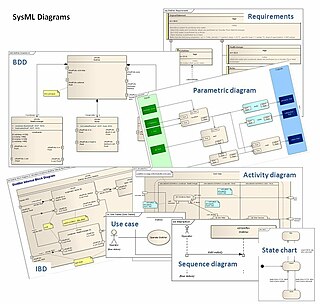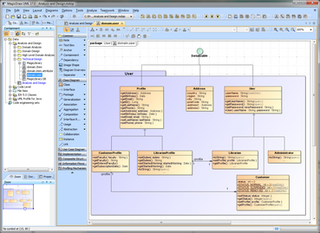
Systems engineering is an interdisciplinary field of engineering and engineering management that focuses on how to design, integrate, and manage complex systems over their life cycles. At its core, systems engineering utilizes systems thinking principles to organize this body of knowledge. The individual outcome of such efforts, an engineered system, can be defined as a combination of components that work in synergy to collectively perform a useful function.
In software and systems engineering, the phrase use case is a polyseme with two senses:
- A usage scenario for a piece of software; often used in the plural to suggest situations where a piece of software may be useful.
- A potential scenario in which a system receives an external request and responds to it.
Structural analysis is a branch of solid mechanics which uses simplified models for solids like bars, beams and shells for engineering decision making. Its main objective is to determine the effect of loads on the physical structures and their components. In contrast to theory of elasticity, the models used in structure analysis are often differential equations in one spatial variable. Structures subject to this type of analysis include all that must withstand loads, such as buildings, bridges, aircraft and ships. Structural analysis uses ideas from applied mechanics, materials science and applied mathematics to compute a structure's deformations, internal forces, stresses, support reactions, velocity, accelerations, and stability. The results of the analysis are used to verify a structure's fitness for use, often precluding physical tests. Structural analysis is thus a key part of the engineering design of structures.

Object process methodology (OPM) is a conceptual modeling language and methodology for capturing knowledge and designing systems, specified as ISO/PAS 19450. Based on a minimal universal ontology of stateful objects and processes that transform them, OPM can be used to formally specify the function, structure, and behavior of artificial and natural systems in a large variety of domains.

The Department of Defense Architecture Framework (DoDAF) is an architecture framework for the United States Department of Defense (DoD) that provides visualization infrastructure for specific stakeholders concerns through viewpoints organized by various views. These views are artifacts for visualizing, understanding, and assimilating the broad scope and complexities of an architecture description through tabular, structural, behavioral, ontological, pictorial, temporal, graphical, probabilistic, or alternative conceptual means. The current release is DoDAF 2.02.

In software engineering, a class diagram in the Unified Modeling Language (UML) is a type of static structure diagram that describes the structure of a system by showing the system's classes, their attributes, operations, and the relationships among objects.
Glossary of Unified Modeling Language (UML) terms provides a compilation of terminology used in all versions of UML, along with their definitions. Any notable distinctions that may exist between versions are noted with the individual entry it applies to.
Web Modeling Language, abbreviated as WebML is a visual notation and methodology for the detailed design of data-intensive web applications. It provides a graphical means to define the specifics of web application design within a structured design process. This process can be enhanced with the assistance of visual design tools.

The systems modeling language (SysML) is a general-purpose modeling language for systems engineering applications. It supports the specification, analysis, design, verification and validation of a broad range of systems and systems-of-systems.

MagicDraw is a proprietary visual UML, SysML, BPMN, and UPDM modeling tool with team collaboration support.
ICONIX is a software development methodology which predates both the Rational Unified Process (RUP), Extreme Programming (XP) and Agile software development. Like RUP, the ICONIX process is UML Use Case driven but more lightweight than RUP. ICONIX provides more requirement and design documentation than XP, and aims to avoid analysis paralysis. The ICONIX Process uses only four UML based diagrams in a four-step process that turns use case text into working code.
Requirements traceability is a sub-discipline of requirements management within software development and systems engineering. Traceability as a general term is defined by the IEEE Systems and Software Engineering Vocabulary as (1) the degree to which a relationship can be established between two or more products of the development process, especially products having a predecessor-successor or primary-subordinate relationship to one another; (2) the identification and documentation of derivation paths (upward) and allocation or flowdown paths (downward) of work products in the work product hierarchy; (3) the degree to which each element in a software development product establishes its reason for existing; and (4) discernible association among two or more logical entities, such as requirements, system elements, verifications, or tasks.

In software development, the V-model represents a development process that may be considered an extension of the waterfall model, and is an example of the more general V-model. Instead of moving down in a linear way, the process steps are bent upwards after the coding phase, to form the typical V shape. The V-Model demonstrates the relationships between each phase of the development life cycle and its associated phase of testing. The horizontal and vertical axes represent time or project completeness (left-to-right) and level of abstraction, respectively.
Axiomatic Product Development Lifecycle (APDL) (also known as Transdisciplinary System Development Lifecycle (TSDL), and Transdisciplinary Product Development Lifecycle (TPDL) ) is a systems engineering product development model proposed by Bulent Gumus that extends the Axiomatic design (AD) method. APDL covers the whole product lifecycle including early factors that affect the entire cycle such as development testing, input constraints and system components.
EAST-ADL is an Architecture Description Language (ADL) for automotive embedded systems, developed in several European research projects. It is designed to complement AUTOSAR with descriptions at higher level of abstractions. Aspects covered by EAST-ADL include vehicle features, functions, requirements, variability, software components, hardware components and communication. Currently, it is maintained by the EAST-ADL Association in cooperation with the European FP7 MAENAD project.
A goal model is an element of requirements engineering that may also be used more widely in business analysis. Related elements include stakeholder analysis, context analysis, and scenarios, among other business and technical areas.
Software requirements for a system are the description of what the system should do, the service or services that it provides and the constraints on its operation. The IEEE Standard Glossary of Software Engineering Terminology defines a requirement as:
- A condition or capability needed by a user to solve a problem or achieve an objective
- A condition or capability that must be met or possessed by a system or system component to satisfy a contract, standard, specification, or other formally imposed document
- A documented representation of a condition or capability as in 1 or 2
The Lifecycle Modeling Language (LML) is an open-standard modeling language designed for systems engineering. It supports the full lifecycle: conceptual, utilization, support and retirement stages. Along with the integration of all lifecycle disciplines including, program management, systems and design engineering, verification and validation, deployment and maintenance into one framework. LML was originally designed by the LML steering committee. The specification was published October 17, 2013.

Sparx Systems Enterprise Architect is a visual modeling and design tool based on the OMG UML. The platform supports: the design and construction of software systems; modeling business processes; and modeling industry based domains. It is used by businesses and organizations to not only model the architecture of their systems, but to process the implementation of these models across the full application development life-cycle.

Capella is an open-source solution for model-based systems engineering (MBSE). Hosted at polarsys.org, this solution provides a process and tooling for graphical modeling of systems, hardware or software architectures, in accordance with the principles and recommendations defined by the Arcadia method. Capella is an initiative of PolarSys, one of several Eclipse Foundation working groups.









